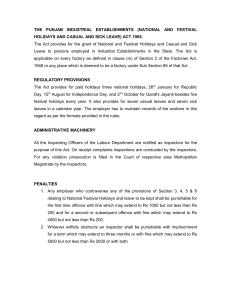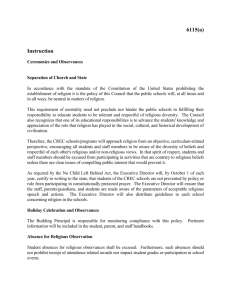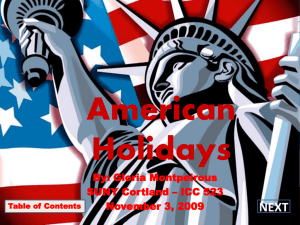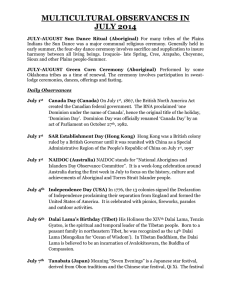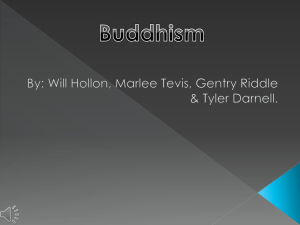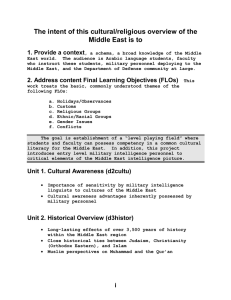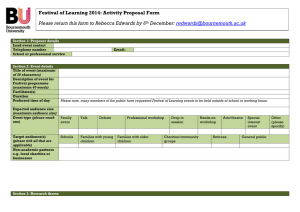Unit 5: Holidays and Observances Objectives Be aware of the following
advertisement
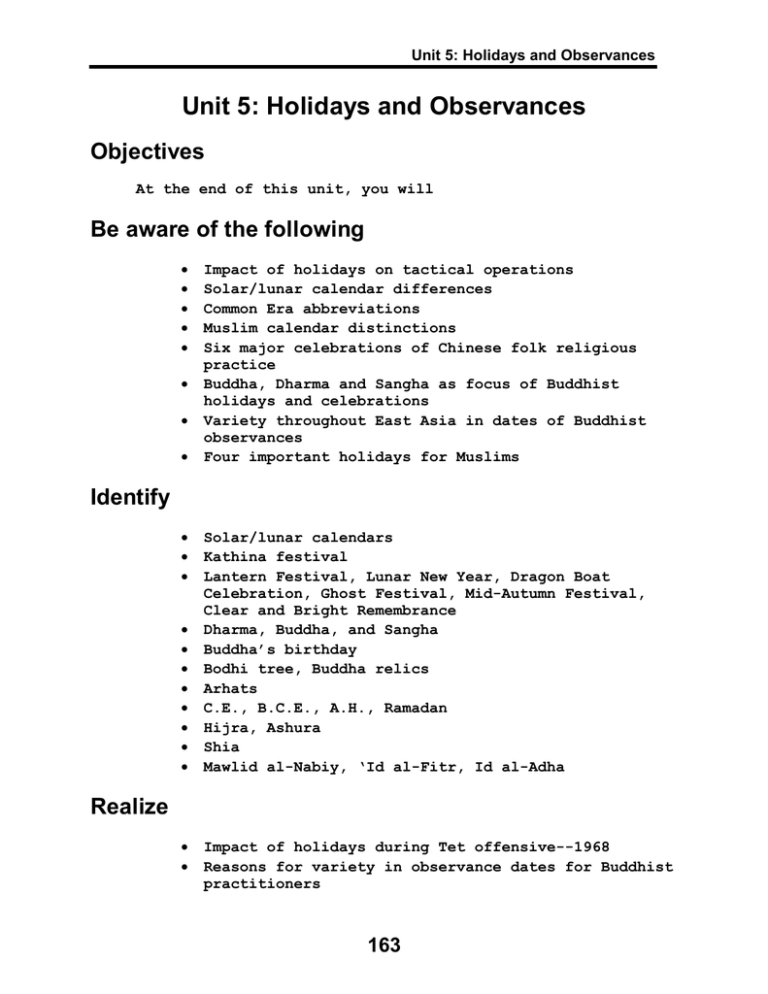
Unit 5: Holidays and Observances Unit 5: Holidays and Observances Objectives At the end of this unit, you will Be aware of the following • • • • • Impact of holidays on tactical operations Solar/lunar calendar differences Common Era abbreviations Muslim calendar distinctions Six major celebrations of Chinese folk religious practice • Buddha, Dharma and Sangha as focus of Buddhist holidays and celebrations • Variety throughout East Asia in dates of Buddhist observances • Four important holidays for Muslims Identify • Solar/lunar calendars • Kathina festival • Lantern Festival, Lunar New Year, Dragon Boat Celebration, Ghost Festival, Mid-Autumn Festival, Clear and Bright Remembrance • Dharma, Buddha, and Sangha • Buddha’s birthday • Bodhi tree, Buddha relics • Arhats • C.E., B.C.E., A.H., Ramadan • Hijra, Ashura • Shia • Mawlid al-Nabiy, ‘Id al-Fitr, Id al-Adha Realize • Impact of holidays during Tet offensive--1968 • Reasons for variety in observance dates for Buddhist practitioners 163 Unit 5: Holidays and Observances Unit 5: Holidays and Observances This section treats selected festivals and observances of Chinese religions, Buddhist, and Muslim practice. Space constraints limit treatment of celebrations important to Hindu, Christian and Jewish practitioners. I. Necessity Knowledge of key holidays and observances contributes to sensitivity and awareness of East Asian culture. In addition, tactical operations also may be directly affected as a result of religious holidays and events. During the Vietnam conflict, enemy actions during the Tet offensive (Vietnamese New Year celebrations) became one of the turning points of the war. As recounted in American Military History’s “The U.S. Army in Vietnam,” the Tet offensive demonstrated anew the importance of holidays/observances in tactical operations. “The Tet offensive began quietly in mid-January 1968 in the remote northwest corner of South Vietnam. Elements of three NVA [North Vietnamese Army] divisions began to mass near the Marine base at Khe Sanh...concern over the critical situation at Khe Sanh and preparations for the Tet holiday festivities preoccupied most Americans and south Vietnamese...Americans were unprepared for what followed. On 31 January combat erupted throughout the entire country. Thirty-six of 44 provincial capitals and 64 of 242 district towns were attacked, as well as 5 of South Vietnam’s 6 autonomous cities, among them Hue and Saigon. Once the shock and confusion wore off, most 164 Unit 5: Holidays and Observances attacks were crushed in a few days. During those few days, however, the fighting was some of the most violent ever seen in the South or experienced by many ARVN (Army of the Republic of Vietnam) units.” (pp. 672-673) II. Hindu/Chinese Religions/Buddhist/Muslim Calendars 1. Solar and Lunar Calendars Beliefs about the world and human interaction within that world determine, in part, how different cultures measure time. Some indicate time according to the sun (solar calendars). Others follow after the moon (lunar calendars). The lunisolar calendar combines aspects of both. 2. Chinese Religions Most Chinese religions follow the traditional lunar calendar. 3. Buddhist Calendars There is no single Buddhist calendar. Throughout East Asia, Buddhist dates vary between different schools of thought and national makeup. 165 Unit 5: Holidays and Observances This is due to the many trends of practice within Buddhism, the diverse nature and importance of Bodhisattvas, unique national patriarchs, historical events and pre-Buddhist traditions which vary from country to country, the different calendars used-whether lunar, lunisolar, Gregorian--and the date of the beginnings of the year. 4. The Muslim Calendar a. A.H. The lunar calendar determines festive dates in the Islamic calendar. Months alternate between 29 and 30 days. This results in a year 354 days long (29.5 x 12 = 354), roughly 11 days short of the solar year. Thus, Muslim festival dates, compared to the Gregorian calendar, vary from year to year. The migration (Hijra, HIJ-rah) of the prophet Muhammad from Mecca to Medina (A.D. 622) begins the Islamic calendar. The Islamic year A.H. 1417 (Anno Hegirae, the year of the Hijra), begins on Gregorian calendar 18 May 1996. b. Ramadan (RAH-mah-dahn) In the ninth month, Muslims fast from first appearance of light to sunset. Depending on the hourly length of days (whether Ramadan falls in summer, winter, spring or fall), fasting may require either very long or short days, depending on the season. c. Muharram (muh-HAR-rahm) and Dhul-Hijja (thul-HIJyuh) Two other months are special-—Muharram, which begins the year, and Dhul-Hijja, the last month which is the time of pilgrimage. Though the moon determines the dating of festivals, prayer times follow the rising and setting sun. During Ramadan, Muslims observe the fast from the first appearance of light to sunset. 166 Unit 5: Holidays and Observances 5. B.C., A.D., C.E., B.C.E. Marked by the birth of Jesus, the Christian era (Anno Domini, Latin for “the year of our Lord”) is abbreviated A.D. Dates before the birth of Christ are designated as B.C. Presently, the initials B.C.E. (Before the Common Era) indicate B.C. (Before Christ.) C.E. (Common Era) denotes A.D. (Anno Domini--in the year of our Lord.) III. Chinese Religions/Buddhist/Muslim Festivals and Observances 1. Chinese Religions The following six celebrations are major events recognized throughout Chinese folk practice. a. Lunar New Year This event is the most important of the Chinese religious year, usually held the second new moon after the winter solstice. The celebration period is for a full month, offering a period of renewal before the spring agricultural work begins. Various feasts honor important household deities. Prior to the New Year’s Eve dinner, sacrifices are made to ancestors and restless spirits. b. Lantern Festival Marking the end of the New Year’s celebration, this event is an opportunity to view and display lanterns. 167 Unit 5: Holidays and Observances On the night of the Lantern Festival, people crowd brightly lit streets to see displays of lanterns and streamers. Tradition dictates that this is a good evening for young women to find husbands. c. Dragon Boat Celebration Remembered near the summer solstice, this event recalls Chu’u Yuan (328-298 B.C.), a Chinese poet and statesman who drowned himself in the Tungting Lake in protest of corruption within the royal court. Boats with dragon heads, representing forces giving rainfall, compete in races and reenact the search for Chu’u Yuan. d. Ghost Festival (yu-lan p’en, “you-lahn puhn”) This Taoist/Buddhist/Chinese festival offers food and prayers for ghosts. These ghosts are harmful spirits-souls that are restless--because of their violent or untimely deaths, ill placed burial sites or neglect by their descendants. The kuei (gway--hungry ghosts) must be appeased. During the ghost festival, the gates of hell are opened and the free roaming kuei receive offerings. e. Mid-Autumn Festival Focusing on the moon, originally this celebration centered on a popular deity known as Ch’ang O (Ch-ahng oh). In celebration of the full harvest moon, people go to the countryside, eat moon shaped cakes, and enjoy the holiday spirit. f. Clear and Bright Remembrance This second most important festival involves visiting ancestral tombs. Family members groom and conserve burial sites, eat together a great feast and offer money/gifts to departed ancestors. The event takes place in the third lunar month--106 days after the winter solstice. 168 Unit 5: Holidays and Observances 2. Buddhist Festivals Buddhist observances cluster around three areas (1) events remembering the personage of Buddha, the Dharma (teaching) and Sangha; (2) rites incorporating remembrances tied to a specific country or ethnic group’s context; (3) commemorations linked to the agricultural/natural season. For purposes here, the focus is on festivals related to the Buddha, Dharma and Sangha. a. Events Honoring the Buddha (1) Buddha’s Birthday Visakha Puja (vis-AHK-ah POO-jah) celebrates the birth, enlightenment and death of the Buddha. According to legend, each one of these events occurred on the full-moon day of the lunar month of Visakha (April-May.) It is the most holy day of the Buddhist calendar. Though festivals differ from country to country, most activities focus on temples and monasteries. People gather to listen to sermons and process in candle-lit movements around temples. Bodhi (BOH-dee) trees are cared for (the type of tree under which Buddha first received enlightenment), Buddha images cleaned, and pilgrimages made to sacred sites. (2) Buddha Images Particular Buddha representations receive honor at differing times. Whether seen as physical representations of the enlightened one, heavenly Buddhas, or as objects worthy of reverence in their own right, ceremonies give respect to figures throughout the Buddhist world. (3) Relics Devotion paid various Buddha relics (tooth, finger bone) can create extreme forms of devotional remembrance. 169 Unit 5: Holidays and Observances b. Dharma Celebrations Particular texts receive veneration on specific days throughout East Asia. In Theravada countries, the Three Baskets (Tripataka-discourse, doctrine, discipline) are honored on the full moon of the eighth lunar month. In Sri-Lanka, Myanmar, Laos and Cambodia, the selfless generosity (dana) of young Prince Vassantara, who gives away all he has, only to be rewarded for his charity, is celebrated on a specific occasion. Merit-and the importance of giving and doing meritorious deeds--is emphasized. c. Festivals in Honor of the Sangha Theravada countries honor the founding of the Sangha in Rajagriha in northern India by 1,250 arhats (AHR-huht--worthy ones). Particular celebrations, marking Sangha foundings, vary from country to country. Often such festivals last for several days with entertainment of plays, dances, comedians, movies and videos. Loudspeakers will blare popular music and announce meritorious gift givers. The beginning and ending of monsoon rain retreats (July--October in Theravada countries) marks the time when the Sangha retreats for collective study and meditation. Kathina festivals--where the Sangha receives new robes and wishing trees (gift bearing structures symbolizing trees)--mark the collective end to the rain retreat. 3. Muslim Festivals and Observances Within Islam, Friday is the day of communal weekly gathering. Based upon the Lunar calendar, Muslims observe the following annual festivals and holidays. 170 Unit 5: Holidays and Observances The first of Muharram (muh-HAR-rahm, New Year’s Day--first month of the Islamic year) celebrates the Hijra of Muhammad and his followers from Mecca to Medina in 622 C.E. (A.D.). a. Ashura (ah-shoo-RA) commemorates the martyrdom of Husayn (hoo-SAYN, grandson of the prophet Muhammad) on the 10th of Muharram, A.H. 61 (C.E. [A.D.] 680). Among Shi’a Muslims, this festival is traditionally celebrated for 10 days, beginning from the first of Muharram. Ashura can also commemorate the safe landing of Noah’s Ark. b. Mawlid al-Nabiy (MOW lid oon-NA-bee, birthday of the Prophet) is the anniversary of the birth of the Prophet Muhammad. For many Muslims, this day ranks third in importance, after ‘Id al-Fitr and Id al-Adha. c. Mi’Raj al-Nabiy (mehr-raj al-NEB-bee) commemorates the ascension (al-Mi’Raj) of the Prophet to heaven following his night journey (al-Isra’) from Mecca to Jerusalem. Interpreted either symbolically or literally, the Qur’an records the event in Sura 17:1. d. Nisf-Sha’ban (nush-if sha-ahBAHN, Night of Repentance) comes on the 14th day of the eighth month (Sha’ban)...in the middle (Nisf) of the month. It is a night of repentance in preparation for Ramadan. e. Ramadan (RAH-mah-dahn) is a holy month of fasting wherein Muslims, who are physically able to refrain, do not eat or drink from the first sign of dawn until sunset. 171 Unit 5: Holidays and Observances f. Jum’at al-Wada’ (juhm-at al-wha-DAH, Farewell Friday) is the last Friday of the month of Ramadan. Though not a strict festival, many Muslims consider it a special day. g. Laylat al-Qadr (LAHAY-let al-KAHD-ehr, Night of Power) commemorates the first revelation of the Qur’an. This event came to the Prophet Muhammad in 610 C.E. (A.D.), when he was forty years old. h. ’Id al-Fitr (i-EED al FAHT-ehr, Festival of the Breaking of the Fast). Along with ‘Id al-Fitr, Id al-Adha (Festival of Sacrifice) comprise the two main Islamic festivals. ‘Id al-Fitr celebrates the end of Ramadan. It comes on the first day of the month Shawwal which follows Ramadan. i. Day of Hajj (al-HAHJ, Day of Arafat) comes on the ninth day of Dhul’Hihha (the month of pilgrimage). It commemorates the concluding revelation to the Prophet at Mt. Arafat, a mountain 18 kilometers east of Mecca. All Muslims on Hajj attend a service on the plains in front of Mt. Arafat (Waqfatu Arafat). j. Id al-Adha (i-EED ahl-OOHD-hah, Festival of Sacrifice) The concluding act of pilgrimage. Muslims offer sheep, goats, and camels in a pattern after Abraham’s offering of his son Ismail to God. The poor and needy receive the meat. Muslims observe these two festivals (Day of Hajj and Id al-Adha) whether on pilgrimage or not. Islam considers Ismail--the son of Abraham and Hagar (thus Abraham’s “firstborn”)--as the rightful heir, the son to be sacrificed. (In the JudeoChristian tradition, Abraham’s second son [Isaac, born of Sarah] is seen to be the true heir, the son to be sacrificed]). 172 Unit 5: Holidays and Observances Vocabulary List: Holidays and Observances ’Id al-Fitr (i-EED al FAHT-ehr, Festival of the Breaking of the Fast) Celebrates the end of Ramadan. It comes on the first day of the month, Shawwal, which follows Ramadan. A.H. Anno Hegirae, in the year of the Hajra Arhats (AHR-huht--worthy ones) 1,250 original members of the first Sangha, meeting in Rajagriha in northern India. Now the term refers to those who have achieved the final stage of enlightenment in Theravada Buddhism. Ashura (ah-shoo-RA) Commemorates the martyrdom of Husayn (grandson of the prophet Muhammad) on the 10th of Muharram, A.H. 61, (C.E. [A.D.] 680) B.C.E. Before Common Era Bodhi Tree (BOH-dee) Type of tree under which the historical Buddha received his first enlightenment. Buddha (BOO duh) Title meaning 'enlightened, awakened one,' and refers to those who attain the enlightenment goal of Buddhist religious life. C.E. Common Era Clear and Bright Remembrance Second most important Chinese festival which involves visiting ancestral tombs. Family members groom and conserve burial sites, eat together and offer money/gifts to departed ancestors. Day of Hajj (ahl-HAHJ, Day of Arafat) Commemorates the concluding revelation to the Prophet at Mt. Arafat, a mountain 18 kilometers east of Mecca. Dharma (DHAR-muh) Teaching--the proper course of conduct, norm, ultimate principles, of Buddhism. Dragon Boat Celebration Event recalling when Chu’u Yuan (328-298 B.C.), a Chinese poet and statesman, drowned himself in the Tungsing Lake to protest corruption in the royal court. 173 Unit 5: Holidays and Observances Ghost Festival Taoist, Buddhist, Chinese festival to kuei (gway), hungry ghosts. These souls of the restless must be appeased through offerings of food and prayers. Hijra (HIJ-ruh) Migration of the prophet Muhammad from Mecca to Medina (A.D. 622) This date begins the Islamic calendar. Id al-Adha (i-EED ahl-OOHD-hah, Festival of Sacrifice) The concluding act of pilgrimage. Muslims offer sheep, goats, and camels in a pattern after Abraham’s offering of his son Ismail to God. The poor and needy receive the meat. Kathina Festival Observance which marks the end of the monsoon rain retreats. The Sangha receives new robes and wishing trees from village members on this occasion. Kuei (gway) Hungry ghosts. These harmful spirits--souls which are restless due to violent and untimely deaths, ill placed burial sites or neglect by descendants--must be appeased. The Ghost Festival fulfills this function. Lantern Festival Event marking the end of the Lunar New Year’s celebration where lanterns are viewed and displayed. Laylat al-Qadr (LAHY-let ahl-KAHD-ehr, Night of Power) This event came to the Prophet Muhammad in 610 C.E. (A.D.), when he was forty years old. It commemorates the first revelation of the Qur’an. Lunar calendar Using the moon to calculate the days marking a given calendar year Lunar New Year Most important Chinese religious year celebration, held the second new moon after the winter solstice. Feasts honor various deities, ancestors and restless spirits. Mawlid al-Nabiy (MOW-lid oon-NA-bee--Birthday of the Prophet) The anniversary of the birth of the Prophet Muhammad. For many Muslims, this day ranks third in importance, after ‘Id al-Fitr and Id al-Adha. Mid-Autumn Festival Celebration of the harvest moon, centered on popular deity of Ch’ang O. People go to the countryside, eat moon shaped cakes and enjoy the holiday spirit. 174 Unit 5: Holidays and Observances Ramadan (RAH-mah-dahn) A holy month of fasting wherein Muslims, who are physically able, do not eat or drink from the first sign of dawn until sunset. Relics Items (tooth, finger bone) thought to originate from the historical Buddha. These items become objects of great veneration. Sangha (SAHN-guh) Buddhist monks and nuns, laymen and laywomen. Shia (SHEE-uh) Muslims who believe Muhammad passed his successorship directly through his bloodline. This school of thought comprises some 15% of Middle Eastern Muslims. Solar calendar: Using the sun to calculate the days marking a given calendar year Tet offensive North Vietnamese Army attack in 1968 which focused on Vietnamese cities throughout the country. This event, conducted during the Vietnamese New Year, proved a strategic turning point in the war. 175 Unit 5: Holidays and Observances Review Quiz: Holidays and Observances Part 1--Multiple Choice Place the letter of the most correct answer in the blank provided. 1. _____ The initials C.E. represent a. Calvin’s Enterprise. b. Common Era. c. Cultural Enlightenment. 2. _____ The initials B.C.E. represent a. Before the Christian Era. b. Before the Common Era. c. Before the Cultural Enlightenment. 3. _____ Islam follows a __________ calendar resulting in a year 354 days long. a. lunar b. solar c. lunisolar 4. _____ The abbreviation A.H. represents a. Anno Hegirae, the year of the Hijra. b. After Hanukkah. c. Ali’s Harvest. 5. _____ The migration (Hijra) of the prophet Muhammad from Mecca to Medina took place in the year A.D. _______. It is the date which begins the Islamic calendar. a. 1492 b. 622 c. 732 176 Unit 5: Holidays and Observances 6. _____ For Muslims _____ is the day of communal weekly gathering. a. Saturday b. Friday c. Sunday 7. _____ __________ commemorates the martyrdom of Husayn on the battlefield of Karbala A.H. 61. It is an important day for Shia Muslims. a. Hijra b. Muharran c. Ashura 8. _____ After ‘Id al-Fitr and Id al-Adha, this day ranks third in importance for many Muslims. a. Mawlid al-Nabiy (birthday of the Prophet) b. Nisf-Sha’ban (Night of Repentance) c. Mi’Raj al-Nabiy (ascension of Prophet to heaven) 9. _____ The two most important Muslim festival/observances are a. ’Id al-Fitr (Breaking of Fast) and Id al-Adha (Festival of Sacrifice). b. Day of Hajj and Mawlid al-Nabiy (birthday of Prophet). c. Christmas and New Years. 10. _____ ____________ is the holy month of fasting for Muslims. a. Muharran (beginning the Muslim year) b. Dhul-Hijja (last month of year--pilgrimage) c. Ramadan 11. _____ The Laylat al-Qadr (Night of Power) commemorates a. the first revelation of the Qur’an. b. the ascension of the prophet to heaven following his night journey. c. the last day of Ramadan. 177 Unit 5: Holidays and Observances 12. _____ The 1968 Tet offensive in Vietnam a. was a total tactical and strategic victory for the North Vietnamese Army. b. celebrated traditional Vietnamese Thanksgiving. c. demonstrates the importance of knowing holidays/observances in tactical operations. 13. _____ Throughout East Asia, Buddhist calendars a. are uniform with little variation. b. vary from country to country. c. all celebrate Zen masters. 14. _____ The most important Chinese festival/observance is the a. Lantern Festival. b. Ghost Festival. c. Lunar New Year. 15. _____ Kuei (gway) are a. hungry ghosts and harmful spirits who must be appeased. b. Buddha relics--teeth and bones. c. ceremonial burial hats worn at Korean funerals. 16. _____ During what festival are participants most likely to eat moon cakes? a. Buddha’s birthday b. Mid-Autumn Festival c. Kathina Festival 17. _____ The most holy day on the Buddhist calendar is a. Prince Vassantara’s Day. b. founding of the Sangha. c. Buddha’s birthday (Visakha Puja). 18. _____ For Buddhists, the significance of the Bodhi tree is that a. it was the favorite place for Buddha to take a bath. b. under this type of tree Buddha received enlightenment. c. its fruit is desired by both living and departed ancestors. 178 Unit 5: Holidays and Observances 19. _____ Visakha Puja (Buddha’s birthday) celebrates a. only Buddhas’ birthday. b. the birth, enlightenment and death of the historical Buddha. c. the birthday of all Bodhisattvas and Buddhas throughout past history and future transmigrations. 20. _____ According to legend, the birth, enlightenment and death of the historical Buddha occurred a. on different days during the lunar month of Visakha. b. on the full moon day of the lunar month of Visakha. c. in what is present day Tibet. Part 2--True/False Place a T or an F in the blank provided. 1. _____ Peoples the world over plan their lives by the solar calendar. 2. _____ Ramadan always comes during the cooler, shorter (light) days of the year. 3. _____ During Ramadan, Muslims fast from 1200-2400 hrs. 4. _____ Many Muslims observe the Day of Hajj and Id al-Adha (Festival of Sacrifice) whether on pilgrimage or not. 5. _____ Arhats are “worthy ones,” wandering ascetic Taoist monks. 6. _____ In Buddhist, the Dharma--important religious texts and writings--are venerated on days of remembrance and celebration. 179 Unit 5: Holidays and Observances 7. _____ One of the reasons for the variety of celebration dates within Buddhism is the way historical events and preBuddhist traditions vary from country to country. 8. _____ Selfless giving (dana) achieves merit within Theravadan Buddhist practice. 9. _____ The Kathina Festival marks the beginning of the Buddhist rain retreat. 10. _____ The “Clear and Bright Remembrance,” a visiting and caring for ancestral burial sites, is the second most important Chinese folk religious festival. Part 3--Matching Place the correct letter in the blank provided. Not all of the letters will be used. 1. _____ Hijra 2. _____ C.E. A. Celebrates the end of Ramadan. It comes on the first day of the month, Shawwal, which follows Ramadan. 3. _____‘Id al-Fitr 4. _____ Solar Calendar 5. _____ Ramadan B. Anno Hegirae, in the year of the Hajj. 6. _____ Lunar Calendar C. Commemorates the martyrdom of Husayn (grandson of the prophet Muhammad) on the 10th of Muharram, A.H. 61. 7. _____ Day of Hajj D. Before Common Era 8. _____ Laylat al-Qadr E. Common Era 9. _____ A.H. F. Commemorates the concluding revelation to the Prophet at Mt. Arafat, a mountain 18 kilometers east of Mecca. 10. _____ B.C.E. 11. _____ Ashura 180 Unit 5: Holidays and Observances 12. _____ Id al-Adha 13. _____ Shi’a G. Migration of the prophet Muhammad from Mecca to Medina (A.D. 622). This date begins the Islamic calendar. 14. _____ Dragon Boat Celebration 15. _____ 16. _____ 17. _____ 18. _____ 19. _____ 20. _____ H. The concluding act of pilgrimage. Muslims offer sheep, goats, and camels in a pattern after Abraham’s Ghost Festival offering of his son Ismail to God. The poor and needy receive the meat. Lunar New Year I. Commemorates the first revelation of Clear and the Qur’an. This event came to the Bright Prophet Muhammad in 610 C.E. (A.D.), Remembrance when he was forty years old. Lantern Festival J. Using the moon to calculate the days Mid-Autumn marking a given calendar year. Festival Kathina K. The anniversary of the birth of the Festival Prophet Muhammad. L. A holy month of fasting wherein Muslims, who are physically able, do not eat or drink from the first sign of dawn until sunset. M. Muslims who believe Muhammad passed his successorship directly through his bloodline. N. Using the sun to calculate the days marking a given calendar year. O. Event marking the end of the Chinese New Year’s celebration. P. Event celebrating the Chinese poet Chu’u Yuan, who drowned himself in protest at the royal court’s corruption. Q. End of the Sangha rain retreat. Sangha members receive new robes and gifts (wishing trees). 181 Unit 5: Holidays and Observances R. Celebration seeking to appease restless souls and spirits. S. Most important Chinese celebration, marking the renewal period before spring agricultural work begins. T. Celebration of the full harvest moon. Participants eat moon cakes. U. Event involving visitation of ancestral tombs, grooming and conservation of burial sites. “Flex Your Brain” 182 Unit 5: Holidays and Observances Sources Used in Holidays and Observances Office of the Chief of Military History, American Military History, (U.S. Army, 1988). Smith, Jonathan, The HarperCollins Dictionary of Religion, (San Francisco: HarperCollins, 1995). Spence, David, The Multifaith Calendar, (Burnaby, British Columbia: Hemlock Printers, 1996). A helpful, accurate, and informative calendar. Artistically done, the calendar not only lists significant events on days when they occur, but also explains their importance in a monthly aside. Thompson, Sue Ellen and Barbara Carlson, (eds.), Holidays, Festivals and Celebrations of the World Dictionary, (Detroit: Omnigraphics, 1994). 183 Unit 5: Holidays and Observances Resources for Further Study MacDonald, Margaret Read, The Folklore of World Holidays, (Detroit, Mich: Gale Research, Inc., 1994). This resource is filled with data on religious and cultural festivals around the world. Most entries are detailed, thorough, and interesting. (Aiso) “Pride in service, pride in self...” (General Gordon R. Sullivan) 184
